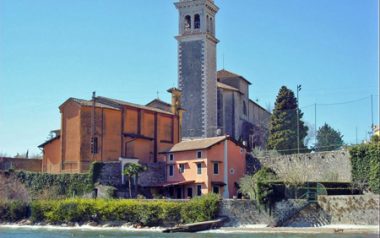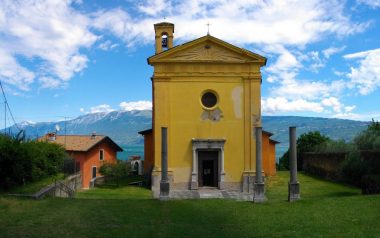Sanctuary Madonna del Benaco
The church is located behind that of the Saints Peter and Paul, in what was the area of the Roman villa of the Nonii Arii and is called “del Benaco” as it stands almost on the lake shore.
Sanctuary Madonna del Benaco: G.P. Brogiolo writes of the chronology of the buildings and their supposed function: “In the pastoral visit of Bishop Bollani and then in the apostolic visit of Federico Borromeo in 1580, the demolition of an apparatus that can be considered to correspond to an early medieval ciborium is prescribed. The columns are those in tonalite, raised in the churchy ard in front of the church. Below was an altar with the statue of the Madonna. The presence of a ciborium and the dedication to Santa Maria could suggest that it was the original church with the care of souls and that St. Peter and Paul from the funerary chapel near the church later became (before 1197) the titular church. The change could have been caused by the difficulty of enlarging the church, built on the slope on the shore of the lake, while it was much easier to rebuild St. Peter’s”.
Andrea De Rossi writes about the interventions on the Sanctuary Madonna del Benaco made by Carlo Borromeo: “So it happened in the Romanesque Basilica of S. Andrea in Maderno, a place where San Carlo Borromeo during his pastoral visit to the Garda Riviera in the 16th century had the underground crypt closed (restored only in 1960) where once the pagans turned to Apollo as well as had the relics of S. Ercolano removed from the urn that, anciently, had contained the remains of the pagan Cesia Festa, a similar event also occurred for the church of S. Maria di Benaco of Toscolano.
In fact, S. Carlo Borromeo also intervened in Toscolano so that the ancient altar could be removed, located in the center of the small church of S. Maria di Benaco which was dedicated to Jupiter Ammon. As the historians Marin Sanuto of 1483 affirm and Ottavio Rossi of 1693 this altar was surrounded by four columns of serpentine, the statue of the Madonna was placed in the center while the idol of Jupiter Ammon was still on the roof of it, in the symbol of Aries or ram (male of the sheep) placed in ancient times by the pagans. The same, from the bottom, burned the sacrifices and the smoke, through an existing hole, invested the Aries. According to Marin Sanuto, above the aforementioned altar there was also a stone which, according to the popular rumor, sweated three times a year: at Christmas, Good Friday and Our Woman in February. The altar was then demolished and Aries torn to pieces to forget the memory of the idolatry, while the columns were saved and were later placed by the Capuchin Don Cristoforo (XVII sec.) after inserting an iron cross instead of pagan figures, on the stairway in front of the church, where they are still found. This altar of sacrifices remained intact until 1580 despite the fact that the Emperor Honorius in 415 had ordered the slaughter of all pagan idols”.


